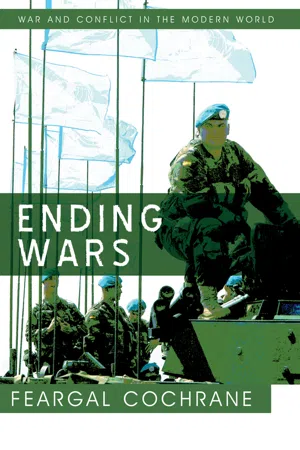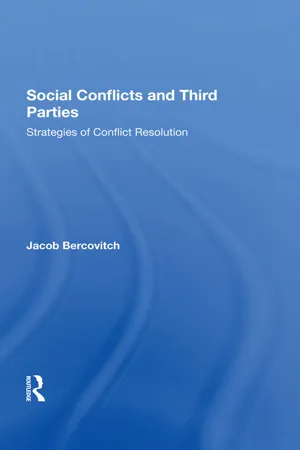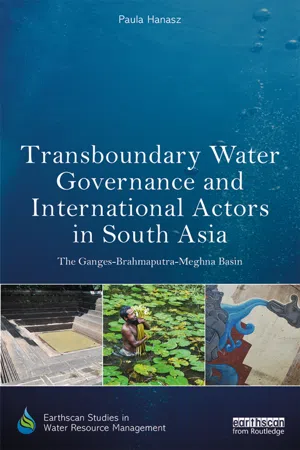Politics & International Relations
Third Parties
In the context of politics and international relations, third parties refer to individuals or groups that are not directly involved in a conflict or negotiation but may intervene to facilitate resolution or support one side. Third parties can include mediators, arbitrators, or external actors seeking to influence the outcome of a dispute. Their involvement can be instrumental in achieving peaceful resolutions and fostering cooperation.
Written by Perlego with AI-assistance
Related key terms
Related key terms
1 of 4
Related key terms
1 of 3
4 Key excerpts on "Third Parties"
- eBook - ePub
- Feargal Cochrane(Author)
- 2013(Publication Date)
- Polity(Publisher)
There is a recognition here, of course, that Third Parties have often made wars worse, fanning the flames of violence by providing weapons and other resources to the direct actors due to vested political, economic or other strategic interests in keeping these wars going. William Zartman has noted that Third Parties have provided resources and sanctuary to conflict actors and have been used to provide leverage in war itself, as well as at the negotiating table. 2 While this chapter will point to occasions where Third Parties have had a destructive impact, the central focus will be on the efforts made to bring armed conflicts to an end. Third-party agencies have both constructive and destructive elements to them and the question to address is not so much can they help in the difficult task of ending war, but, rather, when and how can they do so? What is Third-Party Intervention? Like many other concepts in international relations, the precise meaning of a third party is potentially vast. In their handbook for political negotiators, the NGO International IDEA have provided a useful working definition of third-party intervention that is sufficiently broad to be used here. A third party – a person, group, institution or country that is not identified directly or indirectly with any of the parties or interests to the conflict – can be very effective in chairing or facilitating the talks process. And a long-standing conflict, especially where there is considerable stalemate or just staleness of view, can benefit from the fresh perspective of newcomers. The first two important questions are: Do we need a third party? And, if so, who? 3 A further question could be added to this list, namely what should the third party do when they intervene? The story of external third-party intervention at the transnational level is bound up with the changes that took place at the end of the Cold War period during the early 1990s - eBook - ePub
- Robert Nalbandov(Author)
- 2016(Publication Date)
- Routledge(Publisher)
Chapter 1 Theories of Third-party Intervention DOI: 10.4324/9781315582795-2Success of Third Parties largely depends on the perceptions of the belligerents of the enforceability power of the outcomes the interveners propose. The more the conflict parties respects externally imposed solutions, including sanctions, and who imposes them, the clearer they perceive threats for possible non-compliance with the options proposed by the Third Parties, the more they will believe that the opponents would have exactly same fears from the punitive actions of the interveners, and, thus, would better comply with the proposed outcome by trusting both their rivals and the external actors.There is no unified approach either to the nature of the interveners affecting the end-state of conflicts or to the role of the composition of intervention forces that influences the durability of peace. While for some scholars neutrality of usually multilateral interveners contributes to their successes in the matter of resolving conflicts, for others individual interests of Third Parties make them more decisive in imposing solutions upon the belligerents. The quest for outcome- and objective-based theorizing on successes and failures of interveners starts with definitions of the roles they play, contribution of the compositional dichotomy to the ability of the interveners to successfully pursue their goals, and exploring local conditions in the target counties that either impede or facilitate interventions.With all the complexities of outside actors, in enforcing their decisions upon the belligerents, Third Parties, at large, serve two roles – of an arbiter, a principal decision-maker and an imposer of its will, and a mediator, interested in no particular outcome but in a solution commonly acceptable to all the warring factions. In the first case not only does a third party offer a solution to the conflicting parties but it also enforces it through creation of necessary conditions for its acceptance. This is usually done by a force that the conflicting parties cannot withstand. Third-party further commits itself to keeping the outcome intact and, sometimes, even appoints the winner in the conflict. In doing so, the third party, according to Bloomfield (1995) , “… can quite legitimately employ its own resources to bribe or threaten the disputing parties into agreement”1 or any other outcome. An important aspect of interventions mentioned by Galtung (1965) is that, although the parties may or may not submit to arbitration voluntarily, “in either case they may agree to the solution only if they accept or have to agree”.2 The guarantee of acceptance of the solution is their bias and self-commitment to pursue its objectives “wholeheartedly”. Even if a conflicting party is dissatisfied with the conflict outcome being imposed by the interveners, Third Parties will “…establish a hegemon by helping one side to win or by imposing direct rule by outsiders.”3 - eBook - ePub
Social Conflicts And Third Parties
Strategies Of Conflict Resolution
- Jacob Bercovitch(Author)
- 2019(Publication Date)
- Routledge(Publisher)
The Times , 9.3.1979, 15.3.1979, 16.3.1979 and 20.3.1979). Increasing the price of non-settlement, or the attraction of a settlement, is an important third party activity. In conflicts where the parties appear to be far apart in their position, there are no alternatives to such activities.Third Parties in international conflicts undertake, as we have seen in this section, a range of measures, singly or in combination, which can be looked upon as attempts to change the parties’ evaluation of their conflict and elicit more desired responses. Such measures, be they threats, promises, or direct transfer of resources, alter the parties’ motivation and approach to conflict management. They create a new decision-making context that admits more, and different, preferences, intentions, and expectations, and provides the parties with an incentive to respond in a manner which can increase the likelihood of an acceptable outcome. Third Parties’ directive behavior represents a systematic and conscious attempt to influence the parties’ perceptions and evaluations by modifying their orientation and approach to conflict management. Such behavior co-varies with the strength of the situational, representational, domestic stresses, tensions and other limitations. It is, though, both necessary and effective if the parties are to contemplate new settlement possibilities. Necessary, because parties in international conflict are unlikely to accept expert-based solutions, and effective, because no other type of input will move a party from an entrenched position.The Structure of Intervention
ConsentThe structure of third party activities is related to the formal diplomatic machinery of interactions between states and the notion of non-intervention in the affairs of another state. Activating intervention requires the voluntary acquiescence of the states concerned to internationalizing their conflict, and to allowing a third party to assist with their conflict management. The requirement to secure the parties’ consent places certain limits on third party intervention (e.g. it may often come too late in the conflict), but it remains, nonetheless, a prerequisite for any intermediary activities. - eBook - ePub
Transboundary Water Governance and International Actors in South Asia
The Ganges-Brahmaputra-Meghna Basin
- Paula Hanasz(Author)
- 2017(Publication Date)
- Routledge(Publisher)
1 International actors in the resolution of transboundary water conflictsThis chapter surveys the literature on the resolution of international disputes, and the role of Third Parties in negotiation. The first section of this chapter provides an overview of knowledge about the role of Third Parties in conflict resolution and negotiations. Traditionally those roles have been mediation, conciliation, arbitration and adjudication of disputes. The emphasis was on reaching agreement over specific issues within the limited scope of the negotiation process. The effects of external factors, such as culture or power dynamics between parties to the conflict, were rarely taken into account.In the late 1960s, however, a new method of international negotiations emerged: Track II Diplomacy or dialogue. This is the idea that the relationships built and ideas discussed through informal channels or ‘pre-negotiation’ may have an overall positive effect on levels of cooperation between conflicted parties. The role of Third Parties in Track II dialogue is that of facilitation. The focus shifted away from reaching consensus and towards improving relations between stakeholders so that it would be easier to negotiate agreements in the future.The discussion then turns to transboundary water governance specifically. Very little has been written about how international organisations and foreign aid donors could contribute to transboundary water cooperation. This is despite the fact that the involvement of aid donors and international organisations in transboundary water governance is increasing the world over.What little literature does exist on the role of Third Parties in increasing transboundary water cooperation is covered in the second section of this chapter. Some of this literature suggests that the most important role for external actors is in facilitating benefit sharing arrangements between riparians. This, however, confuses cause and effect. Benefit sharing is largely an outcome of positive water interaction rather than a driver of it. Thus, while neutral Third Parties may be well positioned to mediate benefit sharing agreements (in the same way that a neutral third party can be used to mediate any negotiation), it is unlikely that riparians will come to the formal negotiation table without some degree of trust between them and political will to resolve the issues at hand. In other words, transboundary water cooperation is a precondition of benefit sharing rather than vice versa
Index pages curate the most relevant extracts from our library of academic textbooks. They’ve been created using an in-house natural language model (NLM), each adding context and meaning to key research topics.
Explore more topic indexes
Explore more topic indexes
1 of 6
Explore more topic indexes
1 of 4



